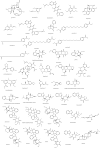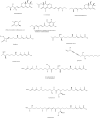The limitless endophytes: their role as antifungal agents against top priority pathogens
- PMID: 38822407
- PMCID: PMC11140875
- DOI: 10.1186/s12934-024-02411-3
The limitless endophytes: their role as antifungal agents against top priority pathogens
Abstract
Multi resistant fungi are on the rise, and our arsenal compounds are limited to few choices in the market such as polyenes, pyrimidine analogs, azoles, allylamines, and echinocandins. Although each of these drugs featured a unique mechanism, antifungal resistant strains did emerge and continued to arise against them worldwide. Moreover, the genetic variation between fungi and their host humans is small, which leads to significant challenges in new antifungal drug discovery. Endophytes are still an underexplored source of bioactive secondary metabolites. Many studies were conducted to isolate and screen endophytic pure compounds with efficacy against resistant yeasts and fungi; especially, Candida albicans, C. auris, Cryptococcus neoformans and Aspergillus fumigatus, which encouraged writing this review to critically analyze the chemical nature, potency, and fungal source of the isolated endophytic compounds as well as their novelty features and SAR when possible. Herein, we report a comprehensive list of around 320 assayed antifungal compounds against Candida albicans, C. auris, Cryptococcus neoformans and Aspergillus fumigatus in the period 1980-2024, the majority of which were isolated from fungi of orders Eurotiales and Hypocreales associated with terrestrial plants, probably due to the ease of laboratory cultivation of these strains. 46% of the reviewed compounds were active against C. albicans, 23% against C. neoformans, 29% against A. fumigatus and only 2% against C. auris. Coculturing was proved to be an effective technique to induce cryptic metabolites absent in other axenic cultures or host extract cultures, with Irperide as the most promising compounds MIC value 1 μg/mL. C. auris was susceptible to only persephacin and rubiginosin C. The latter showed potent inhibition against this recalcitrant strain in a non-fungicide way, which unveils the potential of fungal biofilm inhibition. Further development of culturing techniques and activation of silent metabolic pathways would be favorable to inspire the search for novel bioactive antifungals.
Keywords: Antifungal; Coculture; Endophytes; Fungal biofilm; Multi-resistant fungi.
© 2024. The Author(s).
Conflict of interest statement
The author declares no competing interests.
Figures












Similar articles
-
Alexidine Dihydrochloride Has Broad-Spectrum Activities against Diverse Fungal Pathogens.mSphere. 2018 Oct 31;3(5):e00539-18. doi: 10.1128/mSphere.00539-18. mSphere. 2018. PMID: 30381356 Free PMC article.
-
Dectin-2-Targeted Antifungal Liposomes Exhibit Enhanced Efficacy.mSphere. 2019 Oct 30;4(5):e00715-19. doi: 10.1128/mSphere.00715-19. mSphere. 2019. PMID: 31666315 Free PMC article.
-
In Vitro Activity of a Novel Antifungal Compound, MYC-053, against Clinically Significant Antifungal-Resistant Strains of Candida glabrata, Candida auris, Cryptococcus neoformans, and Pneumocystis spp.Antimicrob Agents Chemother. 2019 Mar 27;63(4):e01975-18. doi: 10.1128/AAC.01975-18. Print 2019 Apr. Antimicrob Agents Chemother. 2019. PMID: 30917977 Free PMC article.
-
Elucidating drug resistance in human fungal pathogens.Future Microbiol. 2014;9(4):523-42. doi: 10.2217/fmb.14.18. Future Microbiol. 2014. PMID: 24810351 Review.
-
Regulation of multidrug resistance in pathogenic fungi.Fungal Genet Biol. 2010 Feb;47(2):94-106. doi: 10.1016/j.fgb.2009.08.002. Epub 2009 Aug 7. Fungal Genet Biol. 2010. PMID: 19665571 Review.
References
-
- World Health Organisation. Global research agenda for antimicrobial resistance in human health. 2023.
-
- AbdelRazek MMM, Elissawy AM, Mostafa NM, Moussa AY, Elanany MA, Elshanawany MA, Singab ANB. Chemical and biological review of endophytic fungi associated with Morus sp. (Moraceae) and in silico study of their antidiabetic potential. Molecules. 2023;28(4):1718. doi: 10.3390/molecules28041718. - DOI - PMC - PubMed
Publication types
MeSH terms
Substances
LinkOut - more resources
Full Text Sources
Molecular Biology Databases
Miscellaneous

